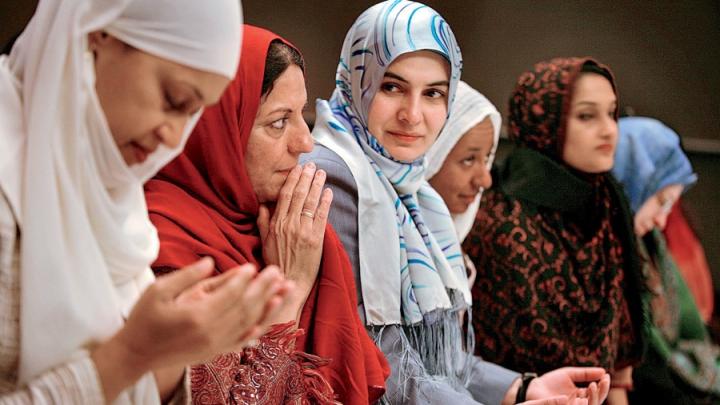One evening in the late 1990s, Thomas professor of divinity Leila Ahmed saw a group of people gathered on Cambridge Common. All of the women were wearing hijab, the headscarf worn by some Muslim women but rarely seen at that time in the United States. Just the sight of hijab provoked a negative, “visceral” response in Ahmed, who was born and raised in Cairo in the 1940s, when even devout Muslim women of the middle and upper classes did not wear veils because they considered them old-fashioned. She took the appearance of veils in Cambridge, she explained recently, to mean that “there could be some fundamentalism taking root in America.”
That incident launched her on a 10-year study of women and Islam and their choices about the veil, and led ultimately to her new book, A Quiet Revolution (Yale). It also led her “into studying the very lively, complicated politics and history that were critical to—and in fact were the driving forces behind—both the unveiling movement of the early twentieth century and, later, of the re-veiling movement in the closing decades of the century,” Ahmed says. In the process, she says, she reexamined her own prejudices and reached surprising new conclusions about hijab. (Among women who wear it today, Ahmed explains, “hijab” usually refers to a veil that covers only the hair and neck; the burqa and niqab cover the face.)
Women in Egypt initially began to unveil around the turn of the twentieth century, as British occupiers sought to rescue Muslim women from what they took to be the oppression of Islam. But local women who unveiled had different reasons for doing so. “Unveiling,” Ahmed writes, “would become ever more clearly the emblem of an era of new hopes and desires, and of aspirations for modernity: the possibility of education and the right to work for both women and men, and of equal opportunity and advancement based on effort and merit.”
In the 1970s, most women began covering their heads again. After Egypt’s defeat in the Arab-Israeli War in 1967, groups that aimed to “Islamize” society, such as the Muslim Brotherhood—quashed under President Gamal Abdel Nasser—reemerged and flourished. At the same time, Saudi Arabia wielded increasing influence as an economic superpower that sought to spread its strict Wahhabi Islam globally. Islamist leaders of the period worked to persuade women to wear Islamic dress, but scholars who interviewed women during this period found that those who adopted it typically reported doing so willingly.
“As is the case sometimes today in America, many of the women who took on hijab did so against parental wishes,” Ahmed says. “Islamic dress gave them new authority as strictly observant religious women, and in a society where men and women were expected to maintain a certain separateness, it gave them the freedom to attend school and go to work—in offices, for example, shared with men—in ways that were socially acceptable. It certainly had some positive outcomes.”
The recent movement in Europe to ban Islamic dress for women echoes the old colonial concern for Muslim women, but Ahmed says it’s layered with something new. Hijab is now identified—wrongly, she believes—with violent strains of fundamentalist Islam. These assumptions, which she shared at the start of her research, “were quite mistaken,” she says now. “Certainly there are violent elements at the extreme edges, but the broad mainstream of the Islamist movement—according to all the experts—is overwhelmingly opposed to violence and committed to nonviolence.” She also emphasizes that the Muslim Brotherhood in particular has a long-standing commitment to social justice, including provision of education and medical treatment to the poor, and she believes such social activism is part of the organization’s legacy in America.
American Islam, she reports, was dramatically altered by 9/11, with more Muslims speaking publicly about their faith, and young Muslims insisting on a new dialogue within Muslim-American organizations. Immediately after 9/11, some women shed their veils to avoid harassment, but others began covering themselves for the first time in their lives. They cited a range of reasons: a desire to affirm their Muslim identity, to educate others and counter stereotypes, and sometimes to express solidarity with the Palestinians. Ahmed was particularly surprised to meet an American Muslim woman in Boston who said she hoped her headscarf would prompt other women to think about gender bias in society, including how clothing choices and physical appearance may influence the treatment of women.
Ahmed’s book has been widely reviewed in the United States and Britain, and she has faced some criticism for suggesting that the veil might symbolize a new kind of Muslim feminism in America; critics say it cannot shake its history as an emblem of oppression. Clearly, Ahmed responds, hijab can’t stand for empowerment in a place like Iran. “In a country where you’re free to choose to wear a veil, its meanings are worlds away from what it means when you’re forced to wear it,” she says. “That’s a critical point. The veil today has no universal meaning. Its meanings are always local.”








